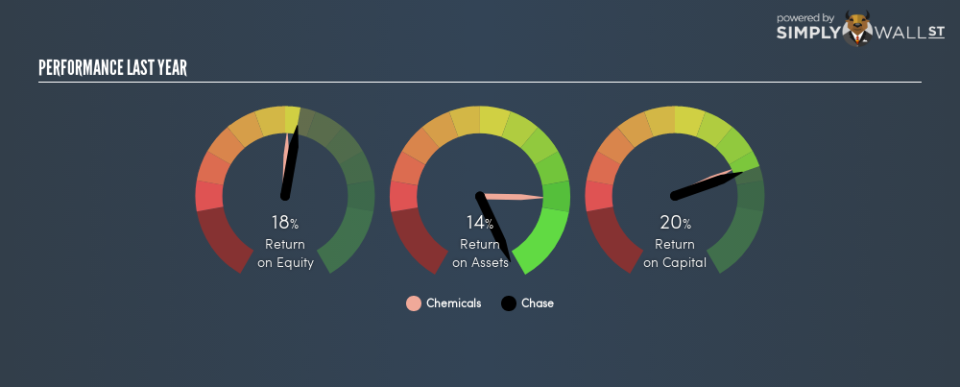Are Chase Corporation’s (NYSEMKT:CCF) High Returns Really That Great?

Want to participate in a short research study? Help shape the future of investing tools and you could win a $250 gift card!
Today we’ll evaluate Chase Corporation (NYSEMKT:CCF) to determine whether it could have potential as an investment idea. Specifically, we’ll consider its Return On Capital Employed (ROCE), since that will give us an insight into how efficiently the business can generate profits from the capital it requires.
First, we’ll go over how we calculate ROCE. Then we’ll compare its ROCE to similar companies. Last but not least, we’ll look at what impact its current liabilities have on its ROCE.
What is Return On Capital Employed (ROCE)?
ROCE measures the amount of pre-tax profits a company can generate from the capital employed in its business. In general, businesses with a higher ROCE are usually better quality. Overall, it is a valuable metric that has its flaws. Renowned investment researcher Michael Mauboussin has suggested that a high ROCE can indicate that ‘one dollar invested in the company generates value of more than one dollar’.
How Do You Calculate Return On Capital Employed?
The formula for calculating the return on capital employed is:
Return on Capital Employed = Earnings Before Interest and Tax (EBIT) ÷ (Total Assets – Current Liabilities)
Or for Chase:
0.20 = US$58m ÷ (US$313m – US$35m) (Based on the trailing twelve months to November 2018.)
Therefore, Chase has an ROCE of 20%.
See our latest analysis for Chase
Does Chase Have A Good ROCE?
ROCE can be useful when making comparisons, such as between similar companies. Chase’s ROCE appears to be substantially greater than the 12% average in the Chemicals industry. We consider this a positive sign, because it suggests it uses capital more efficiently than similar companies. Separate from Chase’s performance relative to its industry, its ROCE in absolute terms looks satisfactory, and it may be worth researching in more depth.
When considering this metric, keep in mind that it is backwards looking, and not necessarily predictive. ROCE can be misleading for companies in cyclical industries, with returns looking impressive during the boom times, but very weak during the busts. This is because ROCE only looks at one year, instead of considering returns across a whole cycle. If Chase is cyclical, it could make sense to check out this free graph of past earnings, revenue and cash flow.
Do Chase’s Current Liabilities Skew Its ROCE?
Liabilities, such as supplier bills and bank overdrafts, are referred to as current liabilities if they need to be paid within 12 months. The ROCE equation subtracts current liabilities from capital employed, so a company with a lot of current liabilities appears to have less capital employed, and a higher ROCE than otherwise. To check the impact of this, we calculate if a company has high current liabilities relative to its total assets.
Chase has total assets of US$313m and current liabilities of US$35m. As a result, its current liabilities are equal to approximately 11% of its total assets. Current liabilities are minimal, limiting the impact on ROCE.
What We Can Learn From Chase’s ROCE
This is good to see, and with a sound ROCE, Chase could be worth a closer look. Of course you might be able to find a better stock than Chase. So you may wish to see this free collection of other companies that have grown earnings strongly.
If you like to buy stocks alongside management, then you might just love this free list of companies. (Hint: insiders have been buying them).
To help readers see past the short term volatility of the financial market, we aim to bring you a long-term focused research analysis purely driven by fundamental data. Note that our analysis does not factor in the latest price-sensitive company announcements.
The author is an independent contributor and at the time of publication had no position in the stocks mentioned. For errors that warrant correction please contact the editor at editorial-team@simplywallst.com.

